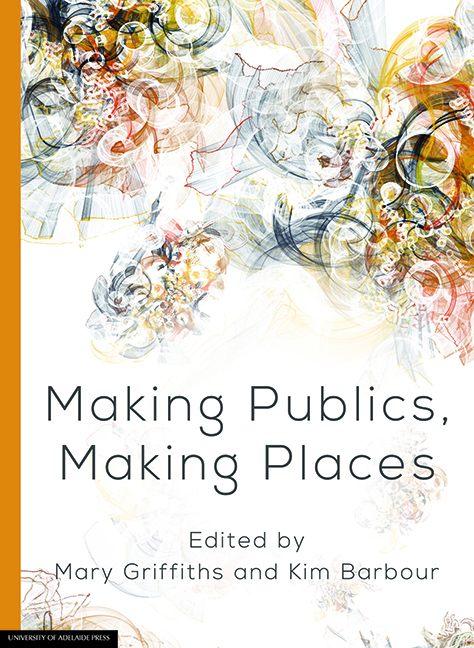Book contents
- Frontmatter
- Contents
- Preface
- Abstracts
- List of contributors
- 1 Making publics, making places
- 2 The elasticity of the public sphere: Expansion, contraction and ‘other’ media
- 3 ‘Imagine if our cities talked to us’: Questions about the making of ‘responsive’ places and urban publics
- 4 Picturing placelessness: Online graphic narratives and Australia's refugee detention centres
- 5 Reclaiming heritage for UNESCO: Discursive practices and community building in northern Italy
- 6 Find your Adelaide: Digital placemaking with Adelaide City Explorer
- 7 Chinese films and the sense of place: Beijing as ‘Thirdspace’ from In the Heat of the Sun to Mr Six
- 8 Social media and news media: Building new publics or fragmenting audiences?
- 9 The use of Chinese social media by foreign embassies: How ‘generative technologies’ are offering opportunities for modern diplomacy
- 10 An opinion leader and the making of a city on China's Sina Weibo
- 11 Public audiencing: Using Twitter to study audience engagement with characters and actors
- 12 Overcoming the tyranny of distance? High speed broadband and the significance of place
4 - Picturing placelessness: Online graphic narratives and Australia's refugee detention centres
Published online by Cambridge University Press: 28 July 2017
- Frontmatter
- Contents
- Preface
- Abstracts
- List of contributors
- 1 Making publics, making places
- 2 The elasticity of the public sphere: Expansion, contraction and ‘other’ media
- 3 ‘Imagine if our cities talked to us’: Questions about the making of ‘responsive’ places and urban publics
- 4 Picturing placelessness: Online graphic narratives and Australia's refugee detention centres
- 5 Reclaiming heritage for UNESCO: Discursive practices and community building in northern Italy
- 6 Find your Adelaide: Digital placemaking with Adelaide City Explorer
- 7 Chinese films and the sense of place: Beijing as ‘Thirdspace’ from In the Heat of the Sun to Mr Six
- 8 Social media and news media: Building new publics or fragmenting audiences?
- 9 The use of Chinese social media by foreign embassies: How ‘generative technologies’ are offering opportunities for modern diplomacy
- 10 An opinion leader and the making of a city on China's Sina Weibo
- 11 Public audiencing: Using Twitter to study audience engagement with characters and actors
- 12 Overcoming the tyranny of distance? High speed broadband and the significance of place
Summary
Introduction
This chapter will examine an online comic published by the Global Mail, ‘At Work Inside our Detention Centres: A Guard's Story’ (Olle & Wallman 2014), which documents the difficult situations faced by asylum seekers who have been detained by the Australian government. Asylum seekers face the dilemma of placelessness on political, psychological and phenomenological levels, and the comic affectively conveys this dilemma to its readers by employing elements of the visual language of online communication used in social networking. An analysis of the comic demonstrates how online communication can also be characterised as engendering placelessness, although in a significantly subtler and less perilous way than seeking political asylum.
This discussion is significant because the media that we use to communicate are strongly tied to our understanding of place as a political, physical and phenomenological experience. For example, the modern conception of national identities was shaped in part by the industries of print, particularly novels and newspapers (Anderson 1997), which were able to connect people across relatively long distances, while Marshall McLuhan suggested that broadcast technologies of radio and television helped to shape a ‘global village’ where physical boundaries could be largely transcended (1964).
Although advances in communication technologies have largely served to extend our political sense of place, theorists of place, such as Edward Relph and Melvin Webber, have argued that our phenomenological sense of place is being eroded by the industrial emphasis on accessibility and efficiency. Webber (1964) noted the rise of urban ‘nonplaces’ such as warehouses, loading docks and freeway overpasses crisscrossed with telephone wires, while Relph (1976, p. 143) described the alienation that humans experience in these kinds of ‘anonymous spaces and exchangeable environments’. Although Relph and Webber were writing in the mid-twentieth century, their theories are even more applicable now. Digital technologies are further streamlining communication, and social media platforms are increasingly aggregating and decontextualising content.
- Type
- Chapter
- Information
- Making Publics, Making Places , pp. 49 - 74Publisher: The University of Adelaide PressPrint publication year: 2016



